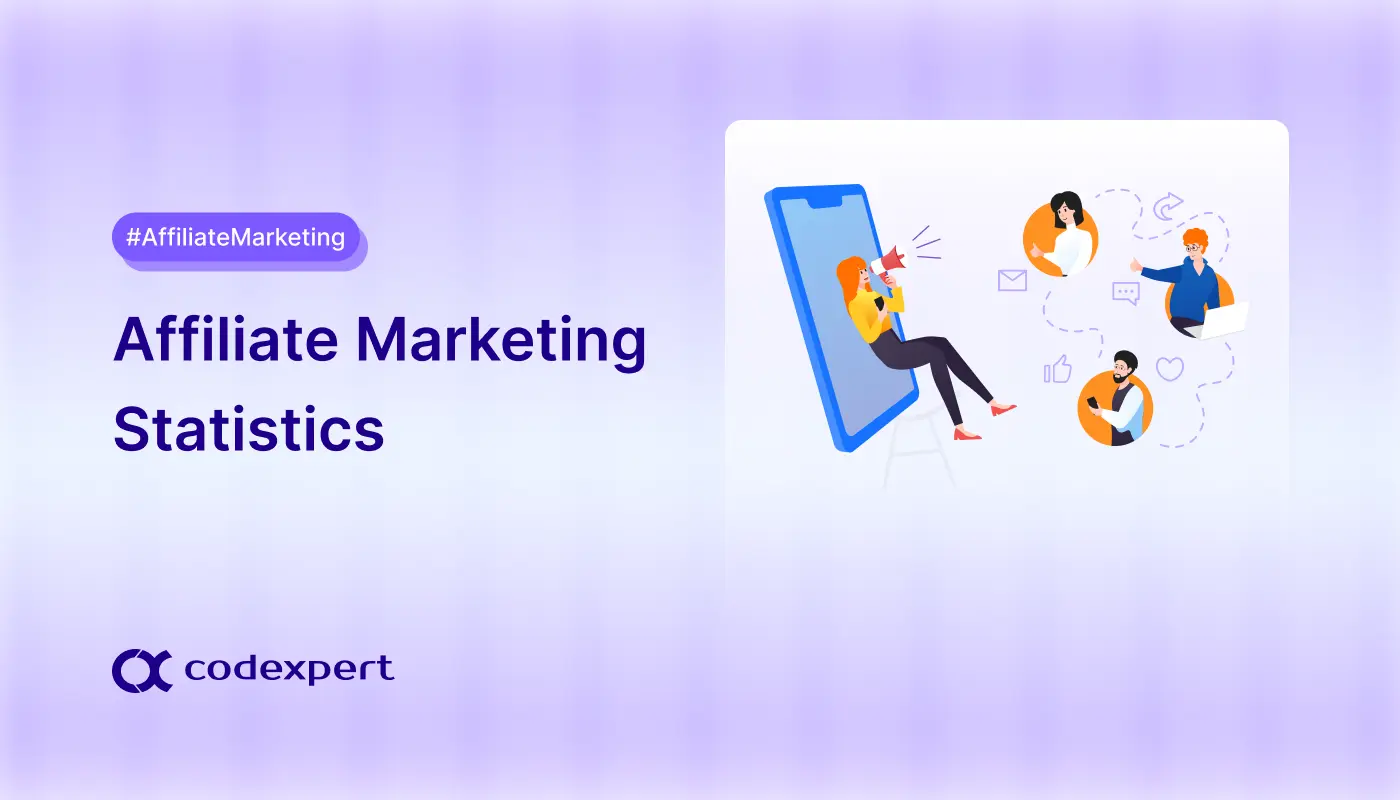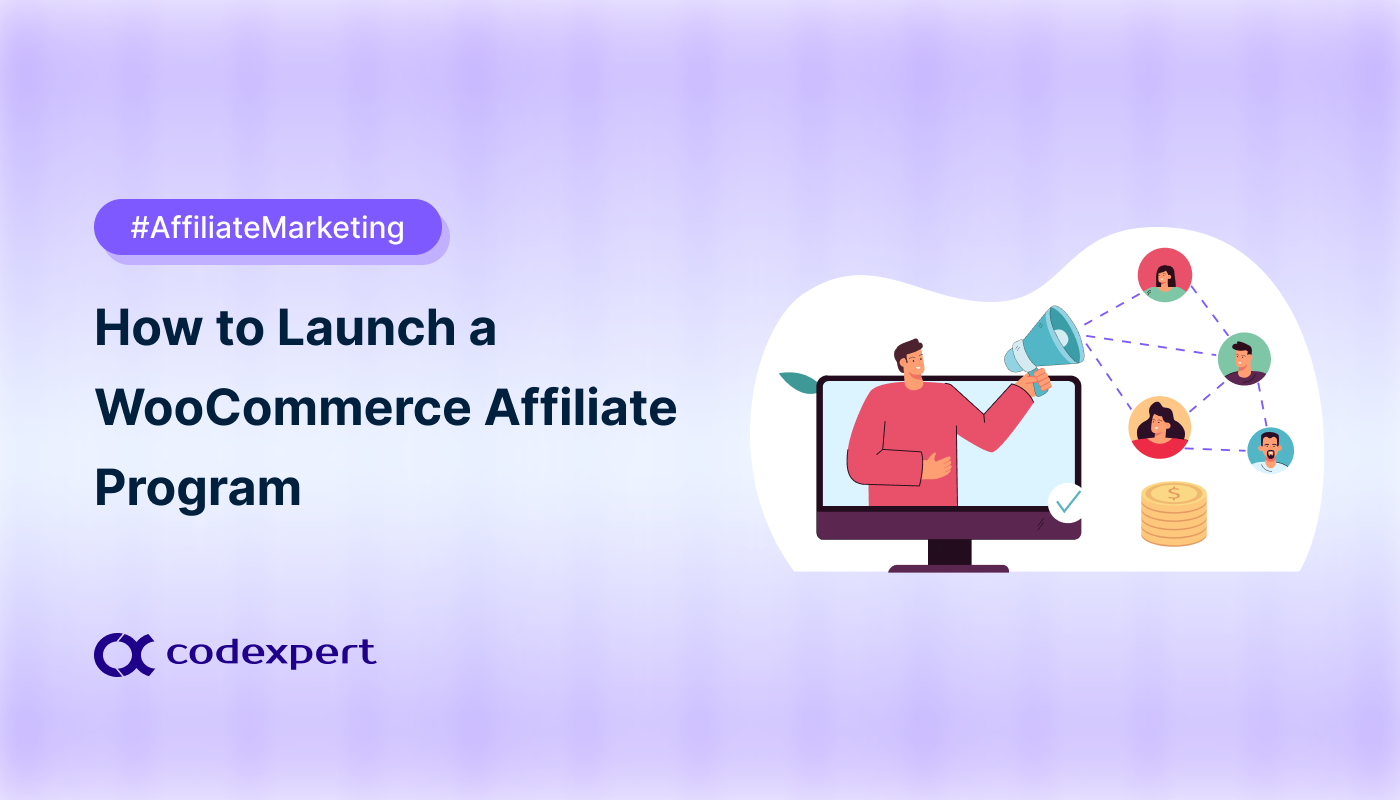What is a Single-Level Affiliate Program? (And Why You Need One)
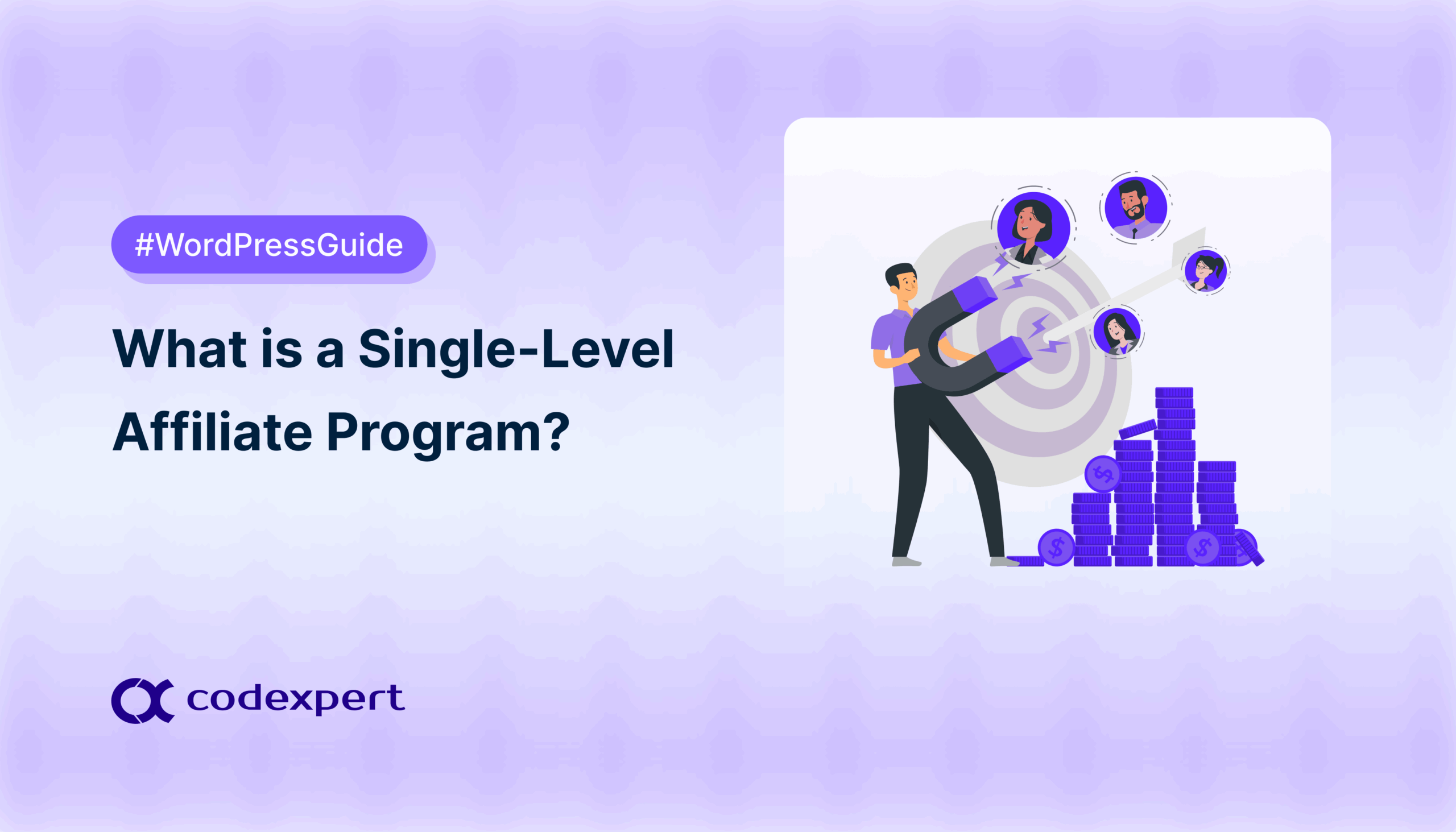
Affiliate marketing allows you to earn commissions without directly promoting your own business. It’s an $18.5 billion industry that’s projected to grow to $31.7 billion by the year 2031.
If you’re looking to recruit affiliates for your business, you’ve probably come across terms like multi-tier or single-level affiliate programs. But what is a single-level program, and why should you consider it for your business?
A single-level affiliate program can be easier to manage, more transparent, and highly effective for certain business models. In this post, we’ll break down how single-level programs work, their key benefits, and why they might be the perfect fit for your affiliate strategy.
What is a Single-Level Affiliate Program?
A single-level affiliate program is a straightforward way for businesses to reward affiliates for promoting their products or services. In this model, affiliates earn commissions only for the sales or leads they personally generate.
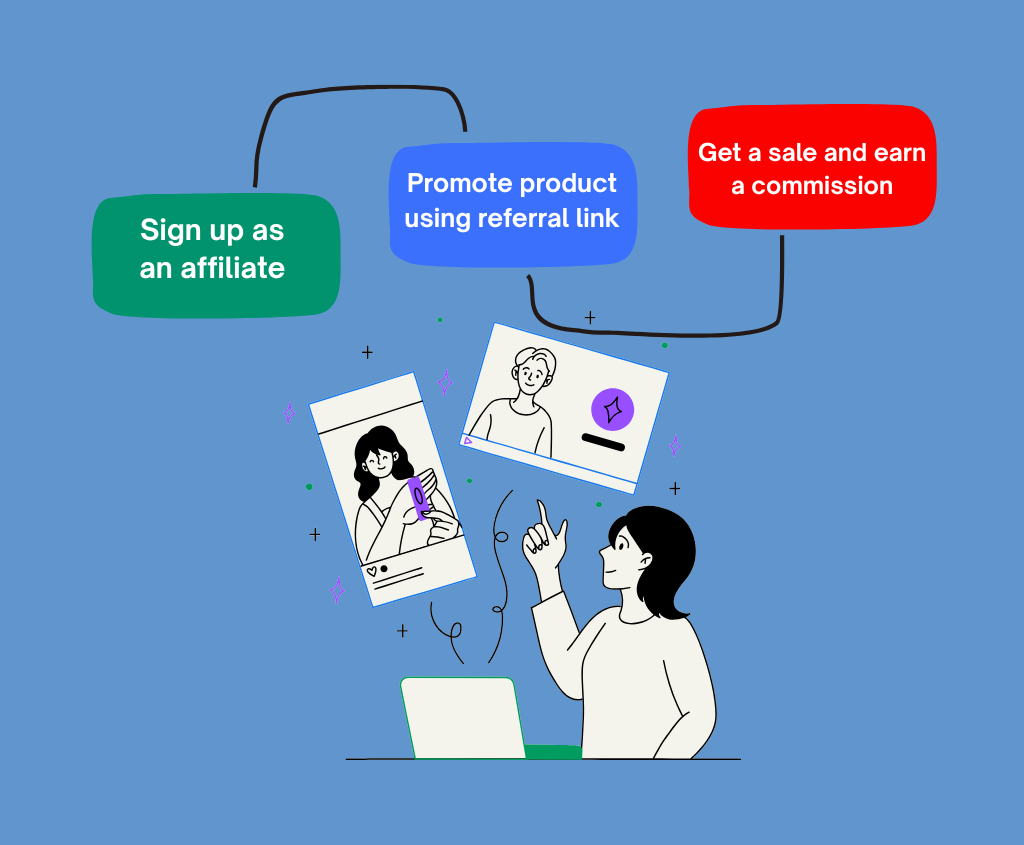
Here’s how it works in simple terms:
- You sign up as an affiliate.
- You promote a product using your unique referral link (on your blog, social media, etc.).
- If someone buys through your link, you earn a commission.
That’s it. No extra commissions from other affiliates’ sales, no pressure to build a team, just direct rewards for your own efforts.
This also makes single-level programs different from multi-level marketing, where earnings depend on both personal sales and recruiting others. With a single-level structure, your success depends purely on how well you promote the product.
Single-level programs are preferred over other programs by businesses because they’re easy to manage, and affiliates appreciate their no-nonsense approach.
Why Your Business Needs a Single-Level Affiliate Program
Now that you have the answer to – what is a single-level affiliate program, let’s take a look at why businesses prefer this over other complex programs.
Before we get into the benefits, it’s best to know that different affiliates work for different businesses, so take a look at what makes single-level programs so great before investing in it.
1. Keep It Simple
One of the biggest advantages of a single-level affiliate program is how easy it is to manage. You don’t need to recruit other affiliates, manage a downline, or handle complex payout calculations.
You only pay affiliates for the sales they directly generate, which lets you focus on growing sales rather than managing a multi-level network.
2. Maintain Control Over Costs
With single-level payouts, you avoid the cascading commission expenses of multi-tier programs. You set one clear rate per sale so budgeting stays predictable, and it protects your profit margins.
Also, there’s no risk of paying out multiple layers of affiliates for the same transactions, as you only need to compensate for direct referrals.
3. Attract Quality Affiliates
Serious marketers (or bloggers, content creators, and niche experts) prefer programs where their earnings aren’t diluted by recruiters or downlines. A single-level model appeals to these performance-driven affiliates, since you can build a network of promoters who genuinely believe in your product and focus on driving sales instead of recruiting others.
4. Encourage Authentic Promotion
When affiliates aren’t focused on building networks, they put more effort into creating honest and compelling promotions for your product.
So, you can expect higher-converting traffic and customers who trust the recommendation, since it’s coming from a genuine user and not someone incentivized to recruit.
5. Build Sustainable Partnerships
Aligning affiliate rewards with direct performance helps you create long-term partnerships based on mutual success. Affiliates who consistently deliver results will stick with your program, and you can avoid the turnover that’s common in MLM-style systems where earnings depend on recruitment.
However, if you’re running an enterprise-level business with a long-running affiliate program, you might profit more from multilevel commission programs.
How to Start a Single-Level Affiliate Program on WordPress (WC Affiliate)
By now, you should know how easy it is to manage a single-level affiliate, but do you know how to set up one?
Lucky for you, starting a single-level affiliate program on WordPress is pretty straightforward. We will guide you through the entire process using WooCommerce along with the WC Affiliate plugin.
Alternatively, you can try EasyCommerce, a WordPress eCommerce plugin, with WC Affiliate to start your single-level affiliate program on WordPress
Let’s get started!
Step 1: Install and Activate
Start by installing and activating the WC Affiliate plugin on your WordPress ecommerce store. The free version is available in the WordPress repository, whereas the pro version can be downloaded from the Pluggable website.
Go to your WordPress website dashboard, then navigate to Plugins > Add New Plugin > Type WC Affiliate in the search box.
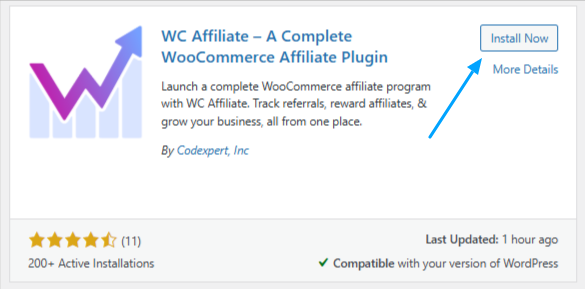
Next, hit Install and then the Activate button. Afterwards, you’ll be redirected to the Installed Plugins interface.
To install the pro version, download the zip file from the Pluggable Dashboard and install it via the Upload Plugin option found within the Add New Plugin page. Click Choose File and upload your licensed WC Affiliate.

You’ll see an Activate Now button; click that and you will be redirected to the Installed Plugins page. Follow the WC Affiliates documentation to get more detailed installation and activation information.
Step 2: Run Setup Wizard
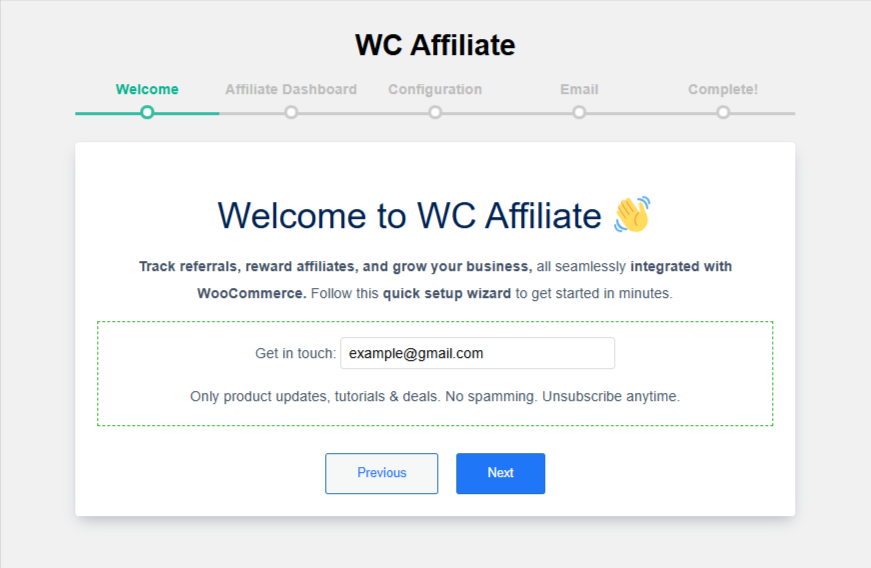
From the Installed Plugins page, click Setup Wizard. There are a total of five pages in the setup wizard, and it’s quite easy to navigate.
- Welcome Page: Enter your email to keep up with updates and deals.
- Affiliate Dashboard: You can either create a new page to show the Affiliate Dashboard or select an existing page.
- Configuration: Select commission base, enter commission rate, and cookie expiry from this section.
- Email: Activate/deactivate admin and affiliate emails.
- Complete: The final page will provide you with links to their support portal, documentation, and their pricing page.
You can customize all the details in the setup wizard page from the WC Affiliates Settings page.
Tip: If you want to show your Affiliate Dashboard on an existing page, include the shortcode [wc-affiliate-dashboard] within that page.
Step 3: Onboard Affiliates
Now that everything is set, you can start onboarding affiliates to your program. Managing affiliate requests and their ongoing tasks is quite straightforward with WC Affiliate.
There are two ways you can onboard affiliates: manually registering them or approving their requests.
1. Manually register affiliates:
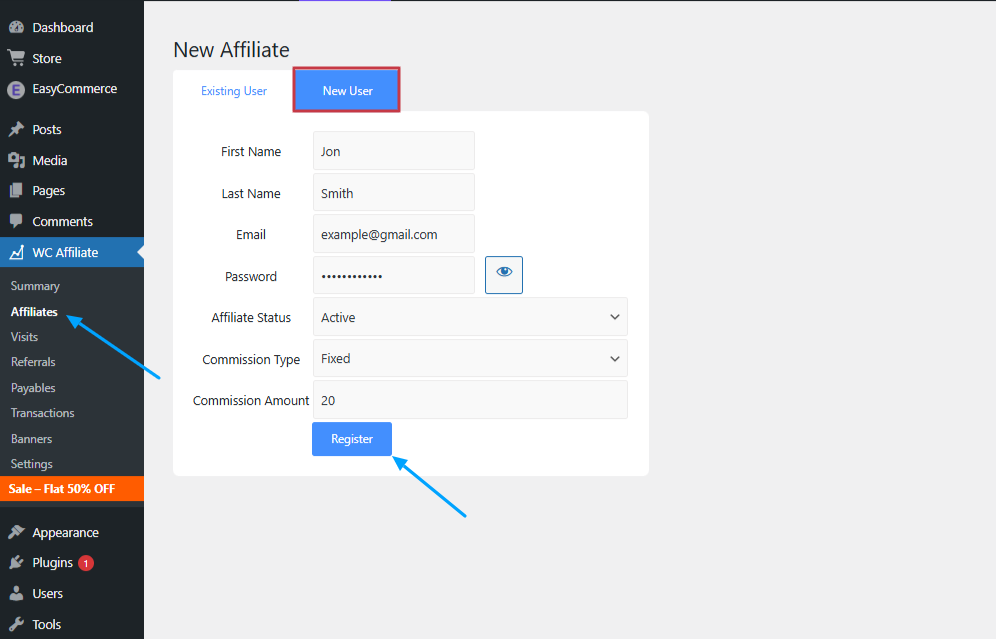
You can manually add affiliates to your program by going to WordPress Dashboard > WC Affiliate > Affiliates > Add New. Click New User, enter the necessary details (name, email, password, status, commission type, and amount), and hit Register.
2. Review/approve affiliate requests:
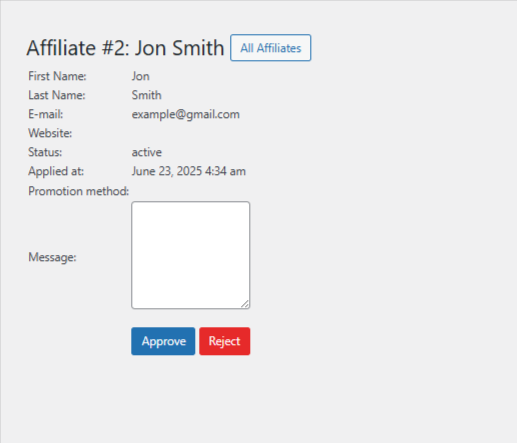
Affiliates can submit a proposal by filling out the request form on their affiliate dashboard page. They are required to provide their name, email address, the website they wish to affiliate with, and an explanation of how they want to promote your products.
Once the request is submitted, you can review it from the Affiliates page. You can also Edit or Report the affiliate.

After reviewing, you can either Approve or Reject the request. If approved, the affiliate will be considered active, after which they can start affiliating with your product. Now you can check visits, payables, and transactions of your existing affiliates from the respective sections.
Why Use WC Affiliate to Run a Single-Level Affiliate Program?
WC Affiliate makes running an affiliate program surprisingly simple and affordable. It is specifically built for WooCommerce, so it slots right into your existing setup without tech headaches.
Here are a few other reasons why it works well for single-level programs –
1. Everything in One Place
WC Affiliate has all the necessary tools to streamline your affiliate program, directly in your WordPress dashboard.
When a sale comes through an affiliate link, it tracks the commission instantly with no manual input. You don’t need third-party integrations or jump between platforms.
2. Quick Setup
You can launch your program in minutes, especially using the setup wizard. You can set commission rules, create signup forms, include them in existing pages, and define payout thresholds.
The dashboard also shows you real-time starts, including clicks, conversions, and overall earnings in a clean and familiar interface.
3. Flexible Commissions
WC Affiliate allows you to assign different commission rates for each level to match your strategy. So, you can cater the commissions depending on the affiliate’s strategy and product knowledge.
4. Customizable Emails
You can send and receive custom emails for both admins and affiliates. You can also enable/disable certain emails from being sent that are triggered by actions.
Wrapping Up
So, what’s the takeaway? A single-level affiliate program keeps things refreshingly simple: affiliates earn commissions only for the sales they directly drive. No complex downlines, no recruitment pressure, just straightforward rewards for genuine promotions.
For businesses like yours, this means predictable costs, easy management, and partnerships built on transparent performance. For affiliates, however, it offers a clear plan for earning and income without team-building hassles.
And if you’re running a WooCommerce store? Tools like WC Affiliate make launching and managing this model easy, right from your WordPress dashboard. If you’re looking to learn “what is a single-level affiliate program”, follow our guide to launch one for your business and boost your profits instantly!
Frequently Asked Questions (FAQs)
What is a single-level affiliate company?
It’s a business that runs an affiliate program where partners earn commissions only for sales they directly refer. There are no multi-tier recruitment or downline payouts.
What is an example of single-level marketing?
A fitness brand pays a blogger 10% commission for every supplement sold via their unique link. The blogger earns solely from their own promotions.
What are the 3 main types of affiliates?
- Content Creators (bloggers, YouTubers).
- Niche Experts (influencers, reviewers).
- Deal/Coupon Sites (focus on discounts).
Do affiliates get paid?
Yes! They earn a commission (e.g., 5–20% per sale or a flat fee) when someone buys through their referral link. Payouts often require hitting a threshold (e.g., $25).
What is an example of an affiliate?
A tech reviewer is linking to a laptop on Amazon. If viewers buy it via their link, they earn a commission from Amazon.
Subscribe to Our Newsletter
Get the latest WordPress tutorials, trends, and resources right in your inbox. No Spamming, Unsubscribe Anytime.

Thank you for subscribing to our newsletter!
Table of Content
- What is a Single-Level Affiliate Program?
- Why Your Business Needs a Single-Level Affiliate Program
- 1. Keep It Simple
- 2. Maintain Control Over Costs
- 3. Attract Quality Affiliates
- 4. Encourage Authentic Promotion
- 5. Build Sustainable Partnerships
- How to Start a Single-Level Affiliate Program on WordPress (WC Affiliate)
- Step 1: Install and Activate
- Step 2: Run Setup Wizard
- Step 3: Onboard Affiliates
- Why Use WC Affiliate to Run a Single-Level Affiliate Program?
- 1. Everything in One Place
- 2. Quick Setup
- 3. Flexible Commissions
- 4. Customizable Emails
- Wrapping Up
- Frequently Asked Questions (FAQs)
- What is a single-level affiliate company?
- What is an example of single-level marketing?
- What are the 3 main types of affiliates?
- Do affiliates get paid?
- What is an example of an affiliate?











